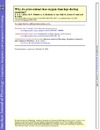Identificador persistente para citar o vincular este elemento:
https://accedacris.ulpgc.es/jspui/handle/10553/6507
| Título: | Why do arms extract less oxygen than legs during exercise? | Autores/as: | Calbet, José A.L. Holmberg ---,Hans-Christer Rosdahl, Hans van Hall, Gerrit Jensen-Urstad, Matts Saltin, Bengt |
Clasificación UNESCO: | 24 Ciencias de la vida 241106 Fisiología del ejercicio |
Palabras clave: | Diffusing capacity Fatigue Oxygen extraction Performance Training |
Fecha de publicación: | 2005 | Publicación seriada: | American Journal of Physiology - Regulatory Integrative and Comparative Physiology | Resumen: | To determine whether conditions for O2 utilization and O2 off-loading from the hemoglobin are different in exercising arms and legs, six cross-country skiers participated in this study. Femoral and subclavian vein blood flow and gases were determined during skiing on a treadmill at approximately 76% maximal O2 uptake (V(O2)max) and at V(O2)max with different techniques: diagonal stride (combined arm and leg exercise), double poling (predominantly arm exercise), and leg skiing (predominantly leg exercise). The percentage of O2 extraction was always higher for the legs than for the arms. At maximal exercise (diagonal stride), the corresponding mean values were 93 and 85% (n = 3; P < 0.05). During exercise, mean arm O2 extraction correlated with the P(O2) value that causes hemoglobin to be 50% saturated (P50: r = 0.93, P < 0.05), but for a given value of P50, O2 extraction was always higher in the legs than in the arms. Mean capillary muscle O2 conductance of the arm during double poling was 14.5 (SD 2.6) ml.min(-1).mmHg(-1), and mean capillary P(O2) was 47.7 (SD 2.6) mmHg. Corresponding values for the legs during maximal exercise were 48.3 (SD 13.0) ml.min(-1).mmHg(-1) and 33.8 (SD 2.6) mmHg, respectively. Because conditions for O2 off-loading from the hemoglobin are similar in leg and arm muscles, the observed differences in maximal arm and leg O2 extraction should be attributed to other factors, such as a higher heterogeneity in blood flow distribution, shorter mean transit time, smaller diffusing area, and larger diffusing distance, in arms than in legs. | URI: | https://accedacris.ulpgc.es/handle/10553/6507 | ISSN: | 0363-6119 | DOI: | 10.1152/ajpregu.00824.2004 | Fuente: | American Journal of Physiology - Regulatory Integrative and Comparative Physiology [ISSN 0363-6119], v. 289 (5), p. R1448-R1458, (Noviembre 2005) |
| Colección: | Artículos |
Este elemento está sujeto a una licencia Licencia Creative Commons

